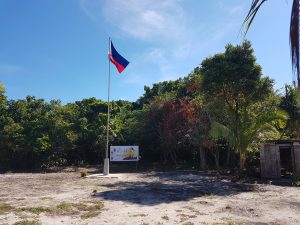Despite successful counterterrorism efforts by the Philippine government, including the recent arrest of two Abu Sayyaf Group (ASG) operatives in Basilan, the insurgency has shown remarkable resilience. How has ASG managed to counterbalance the government’s large preponderance of resources? It has done so by establishing relationships with nearby insurgencies, exploiting coastal populations, and organizing a decentralized command structure. Relying on these factors has allowed ASG to survive, despite a strong focus by the Philippine government on counter-insurgency operations both on land and by sea, including through initiatives like the Trilateral Cooperation Agreement and National Coast Watch System. Understanding how ASG improves its ability to avoid and survive direct confrontation can help counter-insurgency operations achieve long-term success.
Maintaining friendly relationships with other violent non-state actors in the region creates opportunities for collaboration and can provide safe-havens. By supporting nearby insurgencies, ASG members encourage reciprocity. To this end, ASG has long worked closely with other insurgent groups active in the region, including the Philippines-based Moro Islamic Liberation Front, the Bangsomoro Islamic Freedom Fighters, and the Maute Group. Likewise, authorities have established connections between the ASG and the Indonesia-based Jemaah Islamiyah and Jamaah Ansharut Daulah terrorist groups.
ASG’s position along the coast has enhanced its ability to connect with foreign insurgency groups and terrorists. The long history of informal maritime trade and contact across modern national borders facilitates transactions and movements between these illegal groups. The resulting complex familial, political, and ethnic ties make these bonds difficult to identify, especially since they can transcend national borders, reaching into Indonesia and Malaysia. Networking with nearby insurgencies boosts the ASG’s resilience to counter-insurgency operations even when ASG fighters find themselves heavily pressed by government forces, by providing allies outside the direct theater of operations.
In addition to eliciting the support of neighboring insurgencies, ASG also carefully cultivates relationships with local communities. Popular opinion surrounding an insurgency movement can affect recruitment, information flow, and access to supplies. As pointed out in a recent report on the Sulu and Celebes seas, areas with lower levels of coastal welfare and security can prompt locals to become involved in illicit activities. Activities like smuggling, piracy, and armed robbery are often closely entwined with local insurgencies. Despite the recent initiation of government programs designed to boost the maritime economy and agriculture within the Bangsamoro Autonomous Region in Muslim Mindanao, the region still suffers from poverty rates hovering around 53 percent as of 2019.
The ASG uses the prevalence of poverty in the region to encourage recruitment and coerce compliance. The fluctuations by ASG factions along the criminal- terrorist spectrum means certain subgroups are primarily motivated by economic gain as opposed to ideology. As a result, ASG subgroups often entice members of the local populace into supporting insurgency activities in return for compensation when circumstances demand. Reports have indicated that recruits from coastal villages have joined ASG in return for payments of roughly $200, as well as monthly deliveries of rice for their families. By offering to provide assistance to the many families in Mindanao struggling with poverty, the ASG can increase popular support and attract recruits.
In addition, much like government forces, insurgencies benefit immensely from establishing intelligence gathering networks. Informants living along the coasts and in port towns play a critical role in planning operations by identifying targets and afterwards warning of government approaches. In August 2020, for example, a spotter was arrested in Zamboanga City. The unassuming Hamid Udoh Butlangan, a 50-year-old seaweed farmer, had worked alongside the ASG for years to identify potential kidnapping victims. Perhaps more concerningly, on October 20, coast guard apprentice Jailani Al-Rafee Sakandal was arrested in the wake of an attempted port bombing for conspiring with ASG operatives. By using community members to gather information, ASG can remain informed of government movements and identify weaknesses in security, thereby mitigating the amount of risks taken during operations.
By operating in self-sustaining subgroups, each led by a semi-autonomous commander, ASG further enhances its resilience. Unlike in hierarchical command structures, a decentralized system allows ASG members to react opportunistically and independently. This allows subgroups to orient themselves around either practical or ideological motivators depending on financial needs, community support, and the beliefs of core members. For instance, after Abdurajik Janjalani’s death, ASG leaders like Yasser Igasan, Khair Mundos, and Isnilon Hapilon continued to express Islamist ideology while others like Alpader Parad developed more criminal reputations. The usefulness of the system is furthered by the complex geography in which the ASG operates, which consists of a matrix of islands, jungles, and shallows that makes consistent, large-scale collaboration between subgroups difficult.
In addition to increasing adaptability, operating independently also enhances ASG’s resilience by ensuring the defeat of a sub-group does not comprise the integrity of the organization as a whole. Arrests of ASG leaders like Gumbahali Jumdail in 2012, Khair Mundos in 2014, and Abduljihad “Indang” Susukan in 2020 all failed to significantly cripple the insurgency. By giving subgroups a degree of autonomy, ASG can still remain functional despite the capture of high-level leaders.
The Philippine archipelago forms a unique operational environment, underscoring the need for close cooperation between land-based and sea-based security services. Simply scaling up the intensity of counterterrorism operations, however, will struggle to suppress the insurgency without parallel efforts addressing the root causes of the ASG’s resilience. These root causes include a decentralized command system, collaboration with nearby insurgencies, and the goodwill of the local population. By undermining these supporting pillars, authorities can formulate a counterterrorism plan that stands a better chance of achieving long-term success. The factors leading to increased resiliency are difficult to address and require long term solutions, including a stronger focus on developing local population support through coastal welfare programs and increased coordination, both between law enforcement agencies and transnationally.
Michael van Ginkel conducts Indo-Pacific research for the Stable Seas program, which provides innovative research on maritime security issues and organized political violence. He holds a master’s degree in conflict studies and specializes in conflict resolution and peacekeeping operations.

































